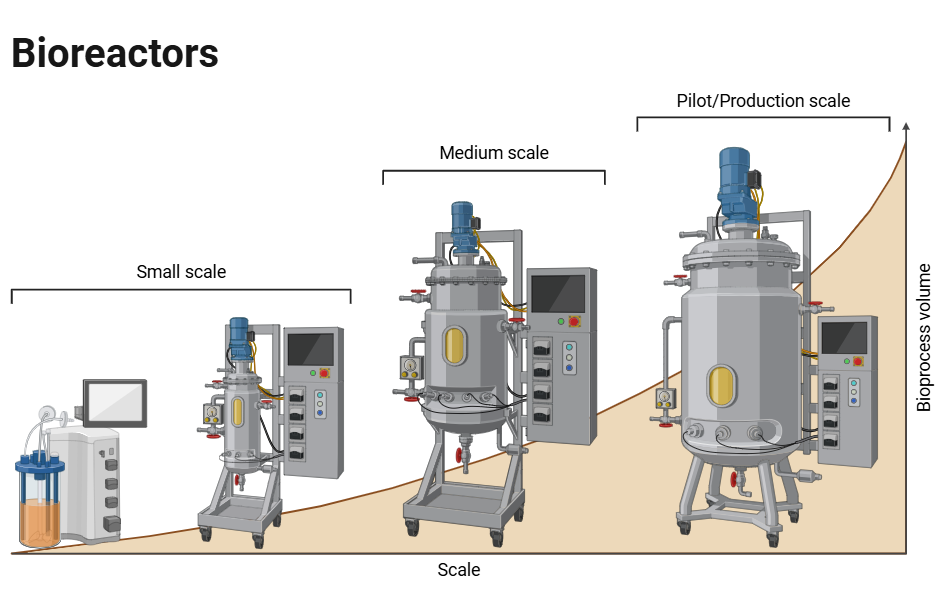Bioreactors are specialized containers that allow the controlled development of cells, enzymes, or microbes. Environmental engineering, biotechnology, and pharmaceuticals are just a few of the disciplines in which they are essential.
What is a Bioreactor?
A bioreactor is an equipment or container that offers a regulated setting for biological processes to take place. By preserving optimal parameters including temperature, pH, oxygen levels, and nutrition delivery, it enables the best possible growth of cells or microorganisms. The size of bioreactors ranges from tiny lab configurations to massive industrial systems.
Structure of a Bioreactor
Complex systems called bioreactors are made to give biological processes the best possible environment. For successful operation and output, it is crucial to comprehend the structure of a bioreactor and each of its constituent parts.
1. Vessel
- Material: Usually composed of quality plastic, glass, or stainless steel, these materials are easy to clean, corrosion-resistant, and able to tolerate high temperatures and pressures.
- Shape and Size: Vessels range in size from laboratory-scale (1–20 liters) to industrial-scale (thousands of liters), and they can be spherical or cylindrical.
- Volume: The bioprocess’s scale is determined by the vessel’s capacity, which also affects operating expenses and product yield.
2. Agitator
- Impellers: Impellers are mechanical devices that guarantee homogeneity by stirring the contents. Depending on the necessary mixing intensity and shear circumstances, impellers can have a variety of configurations, such as radial, turbine, or marine propeller.
- Drive Mechanism: The impellers are powered by a motor or drive system. Depending on the needs of the process, it could have variable speed drives to modify the agitation rate.
3. Temperature Control System
- Heating/Cooling Jackets: External coils or jackets that regulate temperature are known as heating/cooling jackets. Heat can be generated by circulating hot water or steam, and it can be expelled by cooling fluids or cooled water.
- Temperature Sensors: To make sure the internal temperature stays within the intended range, integrated sensors such as thermocouples monitor it.
4. pH Control System
- pH Probes: Sensors that continuously check the culture medium’s pH level are called pH probes.
- Acid/Base Feed Systems: Automated systems that, in response to real-time pH readings, add bases (such as sodium hydroxide) or acids (such as hydrochloric acid).
5. Dissolved Oxygen (DO) Control System
- Oxygen sensors: Track how much-dissolved oxygen is present in the medium.
- Aeration Systems: To improve oxygen transfer rates, employ diffusers and spargers, which are tools that add air or oxygen to a liquid. For greater efficiency, some systems employ pure oxygen rather than air.
6. Sampling Ports
- Access Points: Make it possible to sample the culture media on a regular basis in order to track product production, substrate consumption, and cell development.
- Sterility: Usually has filters or valves to keep things aseptic while sampled.
Also Read: Micropipette – An Overview | Working, Parts, Calibration, Types, and Applications
Types of Bioreactors
1. Batch Bioreactors
These work in a single batch mode, in which all organisms and substrates are added at the start of the reaction and no more is added until it is finished. Although this type is straightforward and simple to use, its yield and efficiency may be limited.
2. Continuous Bioreactors
Continuous bioreactors constantly feed substrates into the reactor while simultaneously removing products. This makes it possible for a steady-state operation, which improves efficiency and productivity, especially for large-scale applications.
3. Fed-batch Bioreactors
This hybrid strategy blends aspects of continuous and batch systems. Higher product yields and improved control over growth conditions are made possible by the gradual addition of nutrients throughout the process.
4. Stirred-tank Bioreactors
These are the most popular kind, distinguished by an impeller that blends the ingredients to guarantee even oxygen and nutrition distribution. Both microbial and cell culture applications can benefit from them.
Single Use Bioreactors
Disposable bioreactors, sometimes referred to as single-use bioreactors (SUBs), are bioprocessing systems that are pre-sterilized and used just once. Due to their many benefits, particularly in the manufacturing of biopharmaceuticals, vaccines, and other biological products, they have become increasingly popular in recent years. This article explores the characteristics, advantages, restrictions, and uses of single-use bioreactors.
Applications of Bioreactors in Pharma
1. Recombinant Protein Production
Genetically modified organisms are used to create recombinant proteins, which are crucial for medical applications, vaccinations, and diagnostics. The expression of these proteins in bacteria, yeast, or mammalian cells is facilitated by bioreactors, which enable precise control over growth conditions and ideal protein folding.
2. Monoclonal Antibody Production
Treatments for autoimmune disorders, infectious illnesses, and cancer frequently include monoclonal antibodies (mAbs). The regulated environment required for the culture of mammalian cell lines (such as CHO cells) that generate these antibodies is provided by bioreactors. Efficient production is made possible by large-scale bioreactors, which guarantee consistent quality and high yields.
3. Vaccine Development
The manufacturing of vaccines, especially those based on live attenuated or inactivated viruses and recombinant subunit vaccines, depends heavily on bioreactors.
4. Enzyme Production
Therapeutic enzymes used to treat a variety of illnesses, including enzyme replacement treatments for hereditary abnormalities, are produced in bioreactors. They make it possible to grow microbial or cell cultures that generate the required enzymes in significant amounts.
Last Modified:
Graduated from the University of Kerala with B.Sc. Botany and Biotechnology. Attained Post-Graduation in Biotechnology from the Kerala University of Fisheries and Ocean Science (KUFOS) with the third rank. Conducted various seminars and attended major Science conferences. Done 6 months of internship in ICMR – National Institute of Nutrition, Hyderabad. 5 years of tutoring experience.






